June 21, 2013
Air Date: June 21, 2013
FULL SHOW
SEGMENTS

Adverse Health Effects For Pigs Fed Genetically Modified Food
View the page for this story
A new long term feeding study finds health problems in pigs fed a diet of genetically modified corn and soy beans. Consumers' Union’s Senior Staff scientist Michael Hansen tells host Steve Curwood that more independent research should be done to determine the safety of GM foods. (06:40)
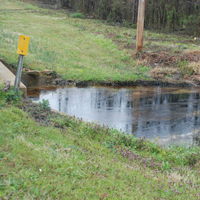
Arkansas Tar Sands Oil Spill Update
View the page for this story
On March 29 an Exxon oil pipeline ruptured in the community of Mayflower, Arkansas, sending 5,000 barrels of diluted bitumen into the community's yards, homes, and waterways. Dustin McDaniel, the Attorney General of the state of Arkansas, tells host Steve Curwood about a lawsuit his office and the federal government have filed against Exxon for violation of the Clean Water Act and the illegal storage of hazardous waste. (06:50)

Helping Fish Return to the Elwha River
/ Ashley AhearnView the page for this story
The biggest dam removal project in US history is nearly complete, and fish can swim freely up the Elwha River again. And as Ashley Ahearn of EarthFix reports, salmon and steelhead trout are getting a helping hand upriver. (07:05)

Turkish Development Threatens Marine Life
View the page for this story
Recent protests in Turkey were sparked by the government's plans to pave over a public park. Journalist Sulmaan Khan joins host Steve Curwood to explain how rapid development in Turkey is causing a host of environmental problems. (06:15)

BirdNote © Willow Ptarmigan
/ Michael SteinView the page for this story
Many birds delight us with their melodious songs. And then, as Michael Stein explains, there's the Willow Ptarmigan, a bird whose voice is more likely to give you a fit of the giggles. (01:55)

The Perfect Protein
View the page for this story
We hear a great deal about the nutritional value of fish, but it seems to be getting increasingly difficult to eat seafood sustainably. This dilemma is the subject of a new book called The Perfect Protein. The author, Andy Sharpless, CEO of the advocacy organization Oceana, joins host Steve Curwood to discuss how we can better manage our fisheries to feed our growing population. (11:15)
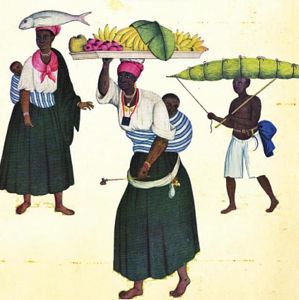
Juneteenth
/ Ike SriskandarajahView the page for this story
African Americans celebrate their ancestors’ emancipation from slavery on June 19th, a holiday known as Juneteenth. On that day, families gather to picnic and cook out across the South. The voyage from Africa isn’t often on people’s minds, but it is in their stomachs. Ike Sriskandarajah digs into the green foodways of the Black Atlantic. (06:15)
This week's EarthEar selection
listen /
download
The echo-location calls of a pair of Noctule bats, as they dive for insects on a June evening in Kent England, from the British Library cd, Vanishing Wildlife.
Show Credits and Funders
Show Transcript
Host: Steve Curwood
Guests: Michael Hansen, Dustin McDaniel, Sulmaan Khan, Andy Sharpless
Reporters: Ashley Ahearn, Michael Stein, Ike Sriskandarajah
[THEME]
CURWOOD: From Public Radio International, this is Living on Earth.
[THEME]
CURWOOD: I'm Steve Curwood. Federal and State officials quickly file suit after an ExxonMobil pipeline ruptures and dumps tar sands oil into a neighborhood in Mayflower, Arkansas. The state's attorney general sees two sides to the oil giant's behavior.
MCDANIEL: I think that they have done a really good job with response and clean up, but then they break the law when they store the stuff that they remove from the site.
CURWOOD: What comes next in the litigation. Also, restoring the salmon and steelhead trout runs on the Elwha River as the dams come down.
MCHENRY: And what we’re going to try to do today is to capture these fish, tag them, and relocate them into the Little River, which is a tributary in the middle part of the Elwha river that has very clean water and high quality habitat.
CURWOOD: Fish and more this week on Living on Earth. Stick around.
[NEWSBREAK MUSIC: Boards Of Canada “Zoetrope” from “In A Beautiful Place Out In The Country” (Warp Records 2000)]
ANNOUNCER: Funding for Living on Earth comes from Stonyfield Farm, makers of organic smoothies, yogurt, and more.
Adverse Health Effects For Pigs Fed Genetically Modified Food

Different levels of stomach inflammation found (clockwise from top left): nil (from a non-GM-fed pig, number B41), mild (from a non-GM-fed pig, number B15), moderate (from a GM-fed pig, number C34) and severe (from a GM-fed pig, number D22).
CURWOOD: From the Jennifer and Ted Stanley Studios in Boston, this is Living on Earth. I’m Steve Curwood. A new study led by a team based at Flinders and Adelaide universities in Australia has found troubling results relating to the health effects of commonly used hog feed that contains genetically modified corn and soy. The Australian researchers partnered with Iowa pig farmers to conduct their study and published the results in the Australian Journal of Organic Systems. Here to explain the results is Michael Hansen, Senior Staff Scientist at Consumer's Union. Welcome to Living on Earth.
HANSEN: Glad to be with you.
CURWOOD: First off, can you explain how this study was conducted?
HANSEN: Well yes, basically what they did is, they took 168 pigs, and they had two different groups. Each had 84 in them, and they basically grew them under commercial conditions for the normal lifespan of the pig. This was a long-term feeding study, 22.7 weeks. That's the time from when a pig is weaned to when it's slaughtered, and they looked at a bunch of health parameters. And the folks that were doing the autopsies and feeding and doing everything with the pigs were blinded - that means they didn't know which pigs they were looking at, whether they were fed engineered grain or not.
CURWOOD: So why do this in Iowa?
HANSEN: Well, the reason it was done in Iowa is because that's where a lot of the problems for years have been reported in pigs.
CURWOOD: What kinds of problems?
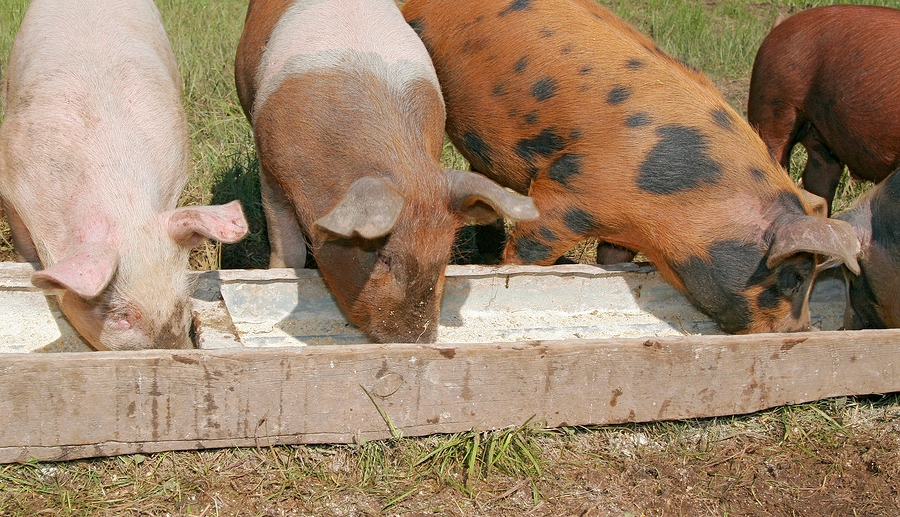
(bigstockphoto.com)
HANSEN: Well, reproductive problems in pigs. Either enflamed stomachs or various forms of reproductive problems. About 10 to 12 years ago, there was a farmer Jerry Rossman who had this problem severely with all of his pigs - reproductive and other problems. And when he would stop using GM and move to non-GM everything got better.
CURWOOD: So what were the results of this study? What did the researchers find?
HANSEN: Well, the two main differences they found: one, there was an increase, statistically significant increase, in severe stomach inflammation. It was about two and a half times higher in the pigs that were fed the engineered grains compared to the non-engineered grains. And the second difference was the weight of the uterus was 25 percent larger and that was a statistically significant increase as well.
CURWOOD: What does it mean in a mammal to have a heavier uterus?
HANSEN: Well, that could suggest that there are problems with the reproductive or hormonal system. And we do know that grains such as soybeans have various levels of phytoestrogen, hormone-like compounds in them, so that's not necessarily surprising. The fact that you see more in the animals being fed the GM grains suggests that that should be looked at further, because it's also consistent with previous studies that have found something similar.
CURWOOD: Now, we reached out to the Biotechnology Industry Organization, it’s a trade group that represents more than 1,000 biotech companies. And they called this research "junk science", and specifically they said in reference to the pigs with inflamed stomachs "the researchers failed to mention in their conclusion that there are more pigs with inflamed stomachs that had eaten the non-GMO diet. Such inflamation is common in animals with high feed intake or that has been finely ground.” In other words, all the pigs had inflamed stomachs. How do you respond?
HANSEN: Well, I think that part of the way to respond to that is, it is truem depending how you want to look at the data. So when you look at severe inflammation it's nine for the non-GM and 23 for the GM-fed. So since there's more in the higher category, of course, there should be less in some of the lower categories. There is one way to look at this and say, “oh it doesn't look like there's anything statistically significant here.” The other way which is how the authors tried to do it is say, “we think there might be a problem with more inflammation.” So they looked at each of those categories independently, and the only one that came up as being statistically significant was the severe inflammation. Which is correct? You can either take the industry’s view, 'oh there isn’t anything here; it’s junk science; we don't need to look further'. The other way is 'it does appear that there is something here; it was a statistically significant effect; it does follow up on previous research; maybe we should look further'.
CURWOOD: Now, to date, industry tells us that there have been hundreds of other feed studies comparing genetically modified, and non-genetically modified feeds and that they overwhelmingly find no evidence of the difference of the two types of feed.
HANSEN: Yes, there are studies that find that. They tend to be funded for and run by the companies. And there are number of studies out there that find that there are also a number of feeding studies have been done with various engineered soybeans and engineered corn varieties that do find adverse effects, whether it’s on the gut or the immune system or reproductive effects or on the kidneys. And I would argue many of the industry ones are not designed very well. They’ll have, for example, small sample sizes - five or 10 animals per treatment - and then you can have a big difference and it's not statistically significant. This study there was 168.
CURWOOD: Wait a second. Give me a statistics lesson here. So if I studied 10 animals...
HANSEN:...per group, for example, you could have a difference that could be 50 percent or 60 percent or even a doubling and that might not be statistically significant because you have such a small sample size.
CURWOOD: A cynic would say then that the studies are designed not to find much of anything.
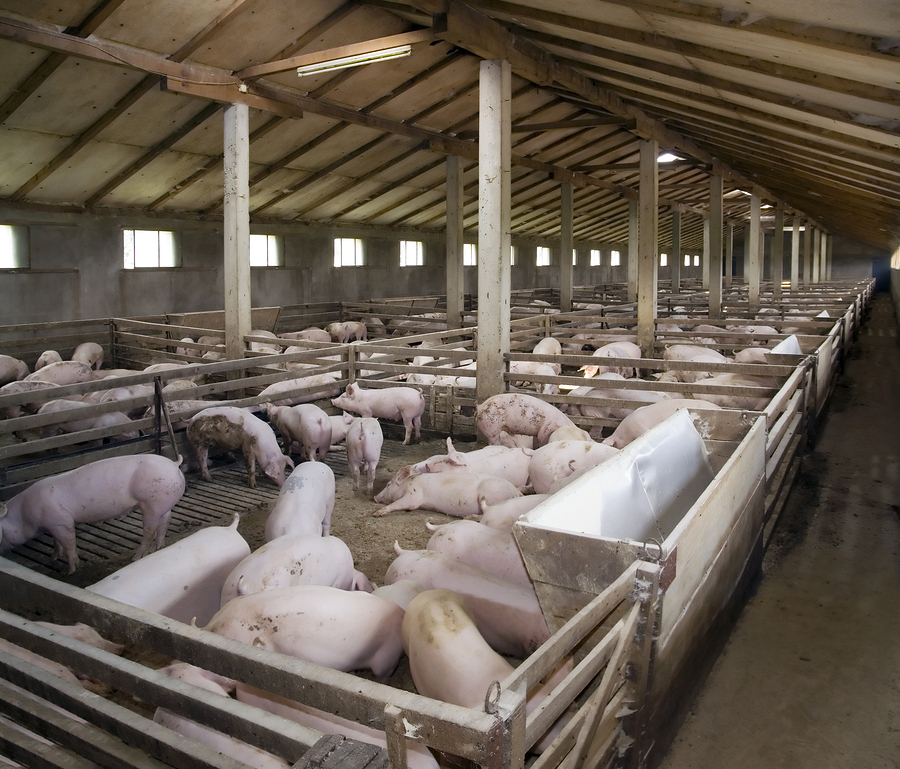
(bigstockphoto.com)
HANSEN: Ah, that’s correct. The folks that tend to find problems are often getting independent funding; they’re not getting funding from the companies.
CURWOOD: What does it say to you that foreign investigators from overseas universities had to conduct this study, that it's not apparently possible to get permission to do this?
HANSEN: Well, I think the reason this was an Australian researcher is because in this country because of intellectual property concerns scientists actually have to go to the companies, and to get the materials to do the experiments they need to get approval from the companies before they're allowed to do the experiments. And that's why, for example, in 2009, 26 scientists wrote to the EPA and said basically we can't do our job because of these intellectual property rights concerns.
CURWOOD: So given this research, given this new information what do you think should be done going forward?
HANSEN: Well, I think what what should be done going forward is: one, this study needs to be repeated. We also need to pass mandatory labeling laws so that people can make decisions for themselves on whether they want to eat these foods. The US is one of the few countries in the world that does not require safety assessments before these foods come out on the market.
CURWOOD: Michael Hansen is a Senior Scientist at Consumer's Union. Thank you so much.
HANSEN: Thank you.
CURWOOD: The statement and an analysis of this study by the Biotechnology Industry Organization are posted at our website, LOE.org.
Related links:
- Read the full report
- Consumer Union
- Statement from The Biotechnology Industry Organization
- Biotechnology Industry Organization Alaysis
Arkansas Tar Sands Oil Spill Update
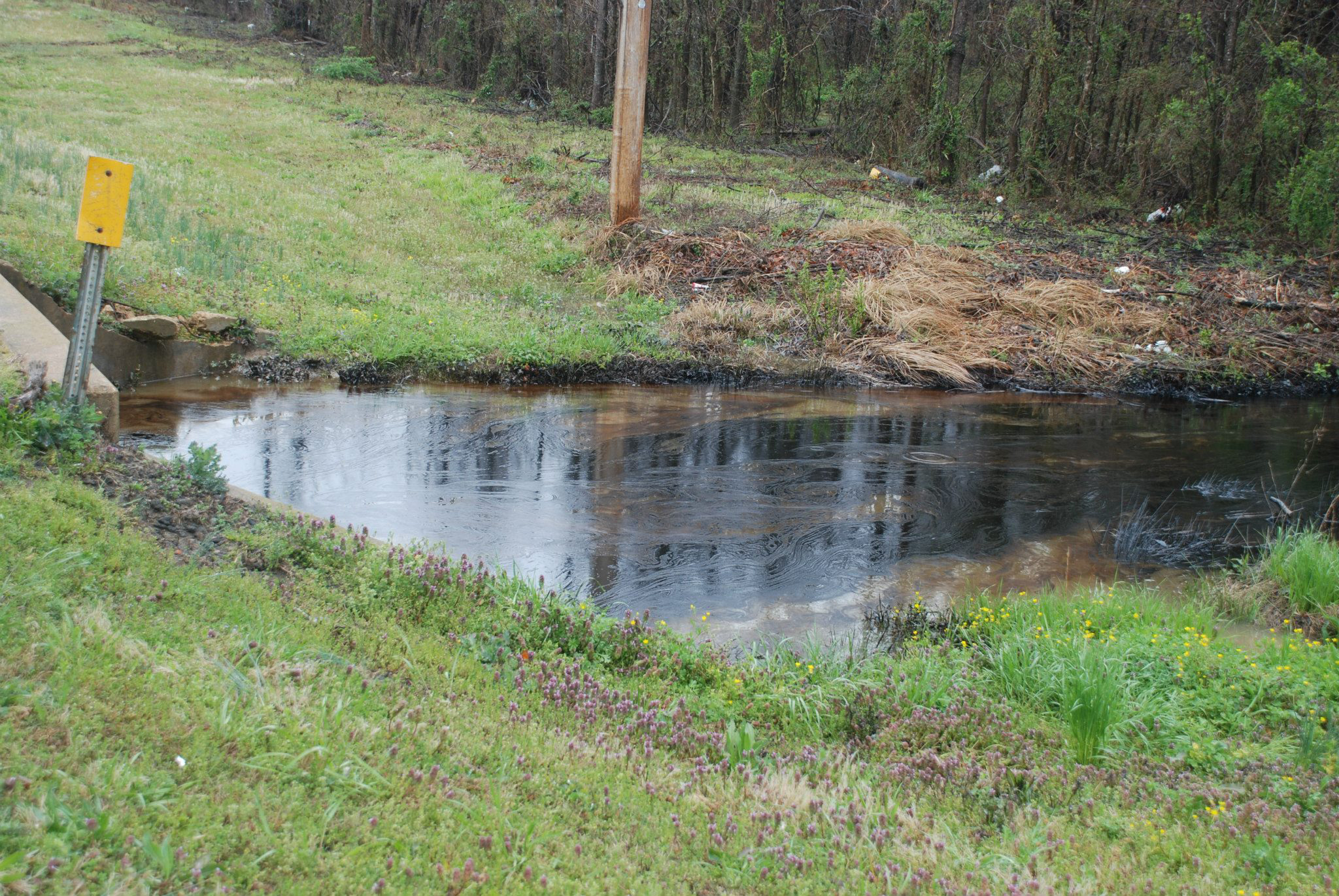
An oil spill in Mayflower shortly after the Exxon pipeline ruptured. (Mayflower, Arkansas oil spill facebook page)
CURWOOD: ExxonMobil, the federal government and the State of Arkansas have already begun battling in court over the spill of tar sands crude from a ruptured pipeline in Mayflower Arkansas that occurred March 29. The rapidly filed lawsuits seek damages from ExxonMobil for 5,000 barrels of diluted bitumen that spilled into the yards and homes of area residents. 22 families were forced to evacuate, and oil has contaminated the local river and lake. Here to explain the new lawsuits is Dustin McDaniel, the Attorney General for the state of Arkansas. Welcome to Living on Earth.
MCDANIEL: Thank you. It's a privilege to be with you.
CURWOOD: Privilege to have you. Now, basic question here - why are you suing Exxon? On what grounds?
MCDANIEL: The lawsuit that was filed by the Department of Justice on behalf of the EPA and my office on behalf of the Arkansas Department of Environmental Quality is simply for penalties under Clean Air and Water Acts and hazardous waste laws. The state and federal government worked together trying to resolve this in a settlement and when that was not successful we filed our lawsuit.
CURWOOD: Now, some have said that this is rather quick, just three months after an incident, to be headed to court with a formal lawsuit; usually these things are negotiated for some time. What's the hurry here?
MCDANIEL: Well, it is rather quick, and I don't think that we anticipated bringing litigation this quickly, but under the law, citizens have the opportunity to file a lawsuit and stand in the shoes of the government if they believe that the government has not or is not adequately litigating the interest of the public. And the only caveat to that is that a citizen lawsuit requires a 60-day notice to the government and the government within that 60 days has the opportunity to either file their own lawsuit and litigate themselves or to some extent abdicate our responsibilities and allow private parties and private lawyers to bring their litigation. That came rather early in this case.
CURWOOD: You got a petition?
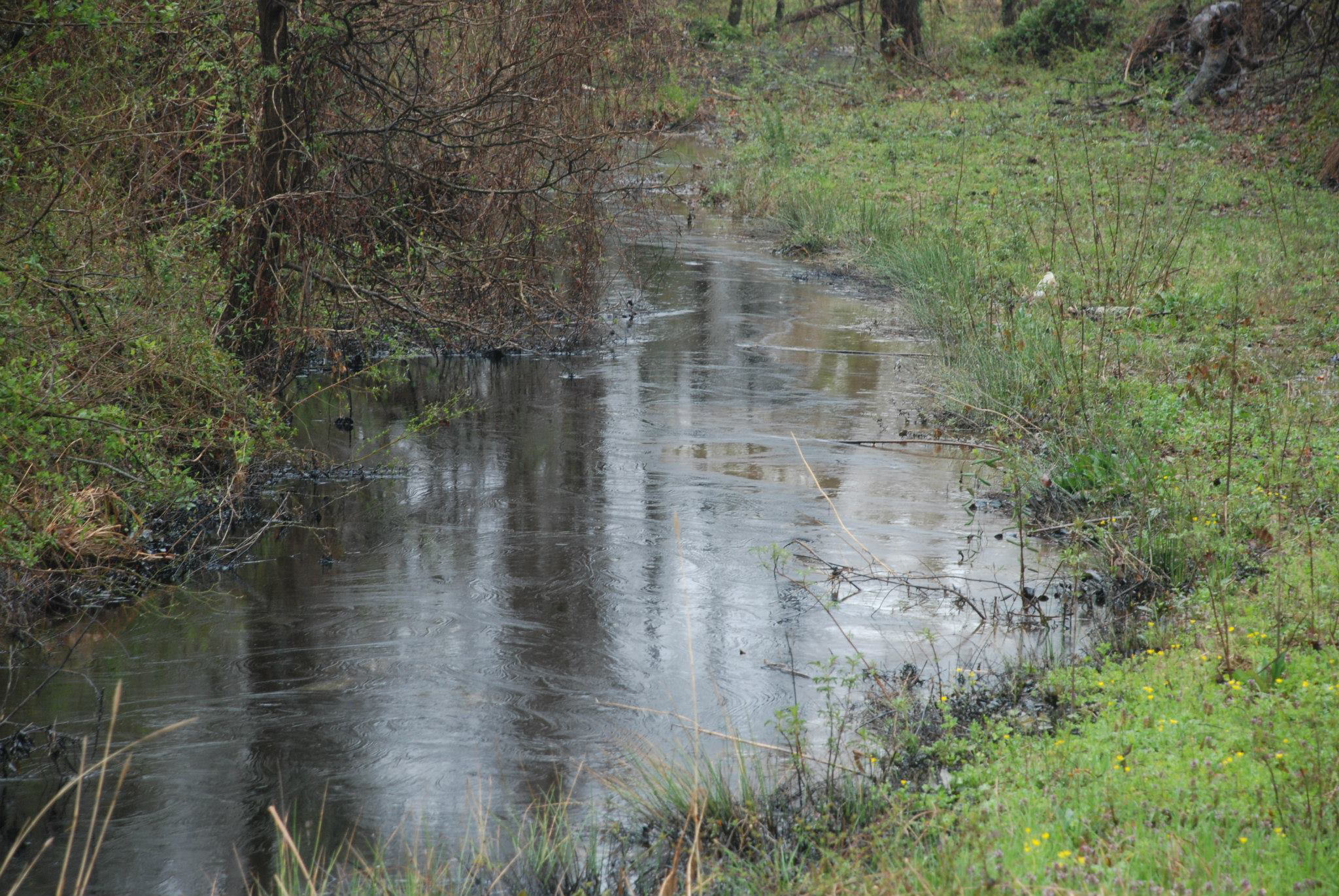
(Mayflower, Arkansas oil spill facebook page)
MCDANIEL: We did. A lawsuit was filed a little over two months ago. The notice came a little over two months ago. And so it to a great extent forced the hand of the state and federal government. And we had 60 days to either resolve our claims or be masters of our own ship and, certainly, I think that the Department of Justice and the State Attorney General’s office have a responsibility to litigate on behalf of the governments of the state and the federal government rather than abdicating that to private lawyers.
CURWOOD: What kind of neighbor is Exxon Mobil being in this situation? Is it a case where they are fully accepting the responsibility and are fully cooperative? Or are they giving you kind of a hard time?
MCDANIEL: You know, I think that it's not as easy as many would like to paint Exxon with one brush or the other. I think that they have done a really good job with response and cleanup, but then they break the law when they store the stuff that they removed from the site. They were, they being Exxon, were taking barrels filled with oil and water, soil, wood, wood chips, etcetera, concrete, things from the cleanup area. And they were transporting these and storing these illegally at a facility that they own not far from the site. Department of Environmental Quality in Arkansas had demanded that they cease-and-desist because they did not have a permit to be storing hazardous material in that location. They did not do so, and they still to this day have material in that facility. So we added a violation of the Arkansas Hazardous Waste Act in this litigation. So I can say fairly, yes, they’re doing well in removing things, but they're breaking the law when they move it somewhere where they shouldn't. I’ll also say that we have a lot of unanswered questions, and their lawyers are very deserving of the reputation that they have of being staunch advocates for their client.
CURWOOD: A tall stone wall.
MCDANIEL: Yeah, Whenever I ask questions about “tell me exactly what you think caused this rupture” which we still don't have even a preliminary answer for, I'm told, “well we wouldn't want to speculate so we’re not...you’ll get the report when everybody else does.” "Tell me when we can expect some assistance from Exxon on the costs of this process because I don't think the taxpayers of Arkansas should be required to bear the burden," we’re told “well, you know, that's premature, and you really shouldn't expect any immediate compensation from Exxon.” They are handling this in a way that is reflective of a major company that has a major release issue every year - and they have - every year for the last four, five years. And so they know how to manage their liability exposure. We're trying to play catch up, and I think we’ve proven to be pretty quick studies.
CURWOOD: Of course, this leak in Mayflower happened just as Washington's heating up with talks about the proposed Keystone XL pipeline. That project, of course, would bring tar sands, crude, and diluted bitumen, this is the same stuff that was being carried by the Pegasus pipeline from Canada's Texas refineries so, Attorney General McDaniel, given your experience in Mayflower what's your opinion of the Keystone XL project?
MCDANIEL: Well, I have been on the record in support of Keystone in the past under the logic that our needs are still present; our pipeline infrastructure is aging; but, this crude...it wasn’t even considered crude oil until...it wasn’t even considered oil...it was a completely different product. It's the consistency of asphalt. It has to be diluted with extremely powerful chemicals, and it does cause a serious environmental impact if it is released even in a small amount. And so I trust Secretary Kerry to carefully evaluate all of the circumstances on whether or not he approves the pipeline. If the pipeline is approved, I fully expect that Mayflower would be a good instructive incident as to why every possible precaution should be implemented and then some. And reminders to those who are going to profit so heavily from the creation of Keystone have to be reminded of the social compact that it is a privilege with which comes enormous responsibilities.
CURWOOD: Dustin McDaniel is Attorney General of Arkansas. Thank you so much for coming by, Sir.
MCDANIEL: It’s a privilege to be with you. Thank you for the good work that you do.
Related link:
Arkansas Attorney General on the Mayflower spill
[MUSIC: Rhythm Of Elements “Airport” from Praia EP (R2 Records 2009)]
CURWOOD: Coming up...a new homecoming for salmon and steelhead trout as the dams come down on the Elwha River. That's just ahead here on Living on Earth.
[CUTAWAY MUSIC: M’Boom: Rumble In the Jungle” from M’Boom (Columbia Records 1979)]
Helping Fish Return to the Elwha River
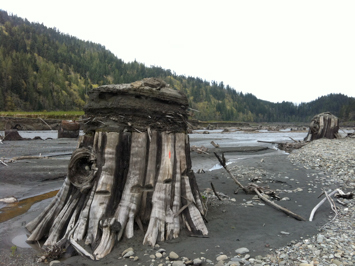
Ancient stumps from the Elwha River bed (Photo: Ashley Ahearn/ Earth Fix)
CURWOOD: It’s Living on Earth. I’m Steve Curwood. Since 2011 the largest dam removal project in U.S. history has been taking place on the Elwha River in the Olympic Peninsula in Washington State, in a bid to restore historic salmon and steelhead trout runs. So much sediment has been released from above the two dams that the final part of the removal was put on hold temporarily. But the murky water hasn’t stopped fish from making the journey upriver to spawn in the reopened habitat. From the public broadcasting collaborative EarthFix, Ashley Ahearn reports, some of those fish are getting help.

Mouth of the Elwha, where millions of cubic yards of sediment, released from above the dams, are creating new beaches and sandbars. (Photo: Ashley Ahearn/Earth Fix)
AHEARN: Mike McHenry stands next to a water treatment plant and a fish hatchery not too far from the mouth of the Elwha River. He’s a fisheries habitat biologist with the Lower Elwha Klallam tribe. We’re looking down a hill at a murky side channel of the river. I can’t see anything in the water below us until McHenry hands me his polarized sunglasses.
MCHENRY: So put these on.
AHEARN: OK...whoa! In the pool below us, several gray, torpedo-shaped bodies move slowly through the brown water.
MCHENRY: So you are looking at several wild winter steelhead. These are the native remnant stock of the Elwha River.
AHEARN: These fish are some of the last of their kind here. Biologists estimate that there’s somewhere between 200 and 300 wild steelhead left in the Elwha. The fish we’re looking at have just returned from several years in the open ocean, fattening up, dodging killer whales and other predators – and now they’re back to lay eggs in their home river. But Mike McHenry says this murky side channel below the dams is the wrong place to make babies.
MCHENRY: And what we’re going to try to do today is capture these fish, tag them, and relocate them into the Little River, which is a tributary in the middle part of the Elwha River, which has very clean water and high quality habitat.
AHEARN: “High quality habitat” because it’s been locked away, above the lower dam, for 100 years. The dam is gone now, but with so much muck and debris in the water, the fish may need some help making their way up into the newly available habitat. That’s where Mike McHenry’s team comes in.
[SPLASHING]

Volunteers from the Coastal Watershed Institute count and measure fish using the newly available estuarine habitat at the mouth of the Elwha this spring (Photo: Ashley Ahearn/Earth Fix)
AHEARN: The biologists net the fish and carry them up the hill one by one, where they’re put in a large tank. There, the team gathers DNA samples, measures each fish and attaches a radio tag so they can keep track of it once it’s released upriver.
[VOICES: Did you get a length on that one? 76 cm. Female right? Yup. Two females.]
AHEARN: John McMillan is a contract biologist with the National Oceanic and Atmospheric Administration and works with McHenry and the tribe. He’s peering down into the tank at a large steelhead. And then he pauses.
MCMILLAN: This is probably brood stock.
AHEARN: 'Brood stock is another term for a fish that has spent time in a hatchery, even though its parents were wild. Hatcheries have been built along rivers around the northwest to supplement wild populations that have been reduced by dams and habitat loss. But research has shown that when some types of salmon and steelhead are raised in captivity they can become domesticated. Other research suggests the brains of hatchery fish don’t grow as big and they don’t produce as many offspring that survive once they’re released. Right now there are two hatcheries in operation on the Elwha River. McMillan runs his fingers along the suspected hatchery fish’s back.
MCMILLAN: We don’t know for sure but this fish has a worn dorsal which is kind of an indicator that it was raised in a hatchery. The fish chew on each other’s fins in the hatchery.
AHEARN: McHenry rests his arms on the tank and looks at McMillan.
MCHENRY: So here’s where we need to make a decision.
AHEARN: Do the biologists bring this hatchery fish up into the pristine habitat above the dam? Or do they leave it here? It’s a decision that government agencies, wild fish advocates and the Lower Elwha Klallam tribe have fiercely debated for years. Here’s the central question: with so few wild salmon and steelhead in the Elwha, should hatchery fish like this one be used as sort of junior varsity subs to boost the overall numbers of fish in this river as it recovers from the dam removal?
[BUCKETS PACKED UP, TRUCK DOORS CLOSE]
AHEARN: The team decides to bring two hatchery-raised fish upstream, along with six wild steelhead. And just to be clear: Mike McHenry and Jon McMillan are not doing anything illegal. In fact, using fish from hatcheries is part of the Elwha River Fish Restoration Plan - and that has sparked a lawsuit.
GLASGOW: We believe that wild fish in the Elwha would recover better in the absence of hatchery influence. You cannot raise a fish in a hatchery without having a negative impact on its genetics and its behavior.
AHEARN: Jamie Glasgow is the director of science and research for the Wild Fish Conservancy. It’s one of the non-profits who filed the lawsuit against the lower Elwha Klallam tribe and several governmental agencies responsible for the Elwha restoration project. Glasgow says that hatcheries aren’t necessary for fish recovery in the Elwha, but if hatcheries are going to be allowed, it should only be for a limited time.
Rob Jones says hatcheries are necessary for steelhead survival in the Elwha. He’s the chief of production for inland fisheries with the National Marine Fisheries Service – one of the defendants in the lawsuit.
JONES: What is very clear to us, crystal clear to us, is that the fish are in such bad shape and the conditions in the river are so unprecedented that any risk that the hatchery poses to these fish is more than outweighed by the benefits.
AHEARN: Jones says the hatcheries will be phased out when salmon and steelhead numbers increase. But the plan does not give a set timeframe or a hard date when the hatcheries will be removed. The science isn’t settled on how hatcheries impact wild fish, though there’s been a debate among fishery managers on that for years. The dam removal going on on the Elwha is truly a grand experiment. No government or tribe has ever tried anything like this before - and no one knows exactly how it will play out. And yeah, right now it’s a difficult place to live if you’re a salmon or steelhead, but it’s not impossible. Last year 500 wild Chinook made the journey above the lower dam to spawn on their own. So far, only a few wild steelhead have made that trip without the help of Mike McHenry and his team.
[RIVER WATER FLOWING]
AHEARN: So, until they’re told otherwise, the biologists will release the hatchery-raised fish with the wild steelhead into the newly available habitat above the lower dam.
[BEEPING]
MCHENRY: No wire coated tag. Wild origin.
AHEARN: McHenry leans down into the cold clear waters of this side creek and unzips a black bag. Two large steelhead slip slowly into the shadows along the bank nearby.
MCHENRY: Moving upstream. We had one going upstream, one go downstream. Based on our experiences they’ll find each other.

Ashley Ahearn (photo: EarthFix)
AHEARN: The biologists have DNA samples from all of the fish they’re releasing today – hatchery and wild. Mike McHenry and John McMillan say that will allow them to see who spawned with whom and which pairings led to more successful offspring.
MCHENRY: It’s a mixture, and that’s what we have.
MCMILLAN: Yeah. It’s all we have to work with and you figure that nature will sort it out ultimately. That's what you hope for, that Nature sorts out who wins and who loses and it will.
AHEARN: For right now anyway, nature is getting a little bit of help in the sorting process.
I’m Ashley Ahearn, on the banks of the Elwha.
CURWOOD: Ashley's story comes to us from the public media collaborative, EarthFix.
Related links:
- Check out the piece on the EarthFix website
- EarthFix is a public radio collaborative reporting on environmental issues in the Pacific Northwest
[MUSIC: Bill Frisell “A Beautiful View” from Big Sur (Savoy Jazz records 2013)]
Turkish Development Threatens Marine Life
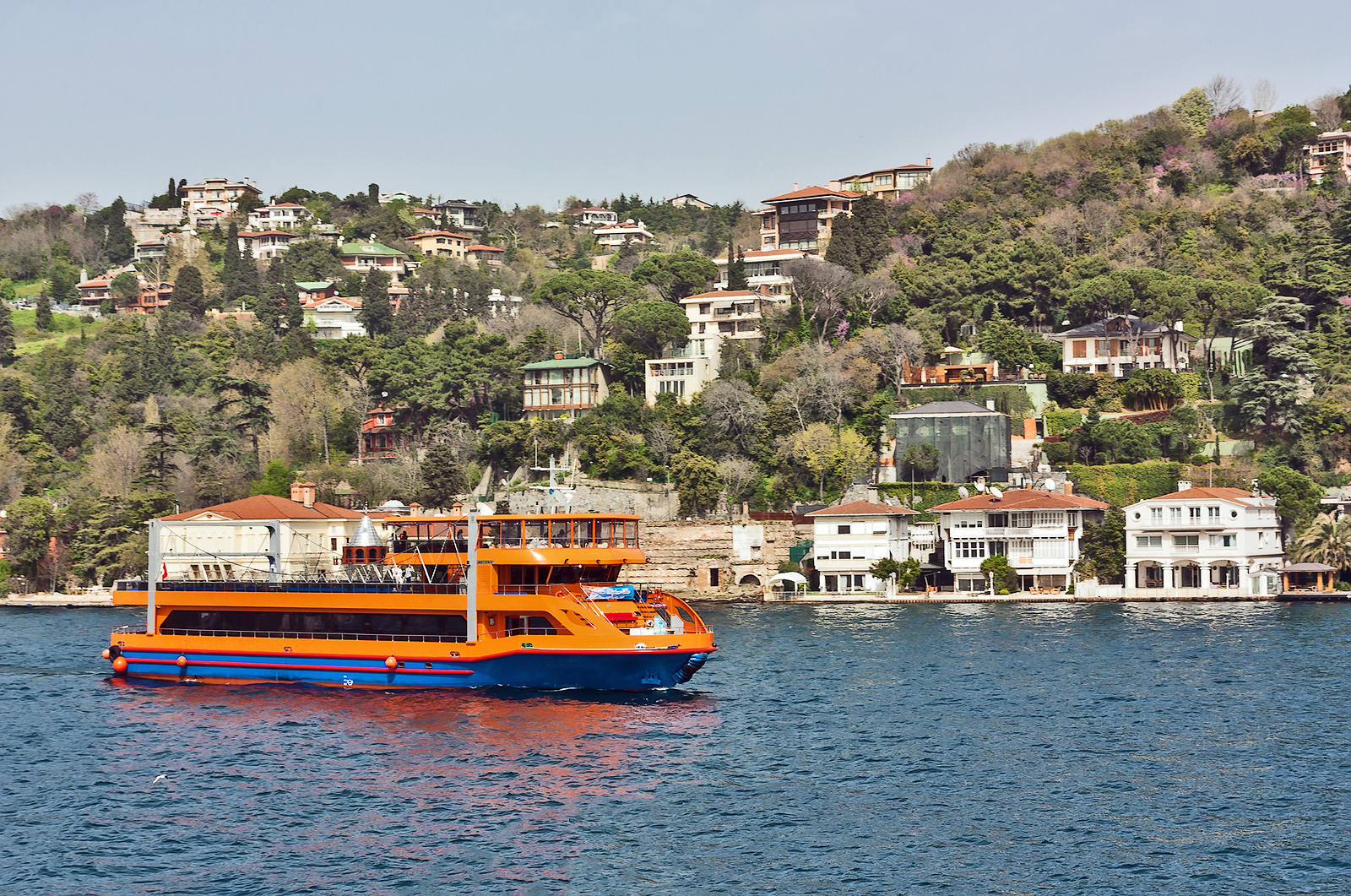
Passenger boat on the Bosphorus (photo: bigstockphoto.com)
CURWOOD: Since the 28th of May, mass protests in Turkey have captured international attention. The demonstrations began when the government announced it would turn Gezi Park, one of the few patches of green in the heart of Istanbul, into a commercial development. Sulmaan Khan is a freelance journalist based in Turkey, and he joins us now from Istanbul to discuss the development policies that sparked these protests and other environmental concerns. Welcome to Living on Earth, Sulmaan,
KHAN: Thank you. It’s a pleasure to be with you.
CURWOOD: Now these protests began after the government announced it was going to develop a public park in Istanbul. Why do you suppose that environmental activism was the catalyst for these protests?

Protest signs in Taksim Square (photo: Anna Beth Keim)
KHAN: My sense is that it’s because the environmentalists in Turkey - small though they might be in number - are incredibly committed and incredibly passionate people. The government’s plans for redeveloping the area included building a shopping mall on the park, and that meant razing a few hundred Sycamore trees. Environmentalists objected to this and began to protest, and the protests as they stand now are about something much more than the environment. But they started off with the environment as a trigger.
CURWOOD: This park isn’t the only major development project in Turkey. Please describe for me the development policies of Prime Minister Erdogan.
KHAN: Well, he’s campaigned on development. Recently when he was holding a rally in Istanbul, one of the themes he kept returning to was all the things he had done in terms of development. We have built factories; we have built schools; we brought running water to houses, which is fair to say he did. That has been his calling card, and that’s at the root of his popularity in many ways, because Turkey. like most developing countries. is a place where basic economic issues are very important. You can see this government revering development in all sorts of arenas, whether it’s coastal development along the Mediterranean, whether it’s the massive increase in fishing, whether it’s the dramatic construction of the third bridge that will connect Istanbul’s European and Asian sides out in places where there are very few people living right now, but where they have to clear massive swaths of forest for construction to begin. So for this government, development clearly does trump environmental concerns. And that has been one of its keys to success.

Sulmaan Khan in Istanbul (photo: Anna Beth Keim)
CURWOOD: You recently wrote an article in Yale’s E360 about the impact of development on Turkey’s marine ecosystems. For those of us who aren’t familiar with Turkish geography, please describe the seas around Istanbul for us.
KHAN: Istanbul’s a place where world’s meet, and some of the worlds that meet are marine ecosystems, the Mediterranean and the Black Sea. They’re connected by the Bosphorous and the Sea of Marmara which run through Istanbul. So as a corridor between two ecosystems, the Mediterranean and the Black Sea, Istanbul’s waterways are of tremendous importance to a host of marine life, including three types of dolphins.
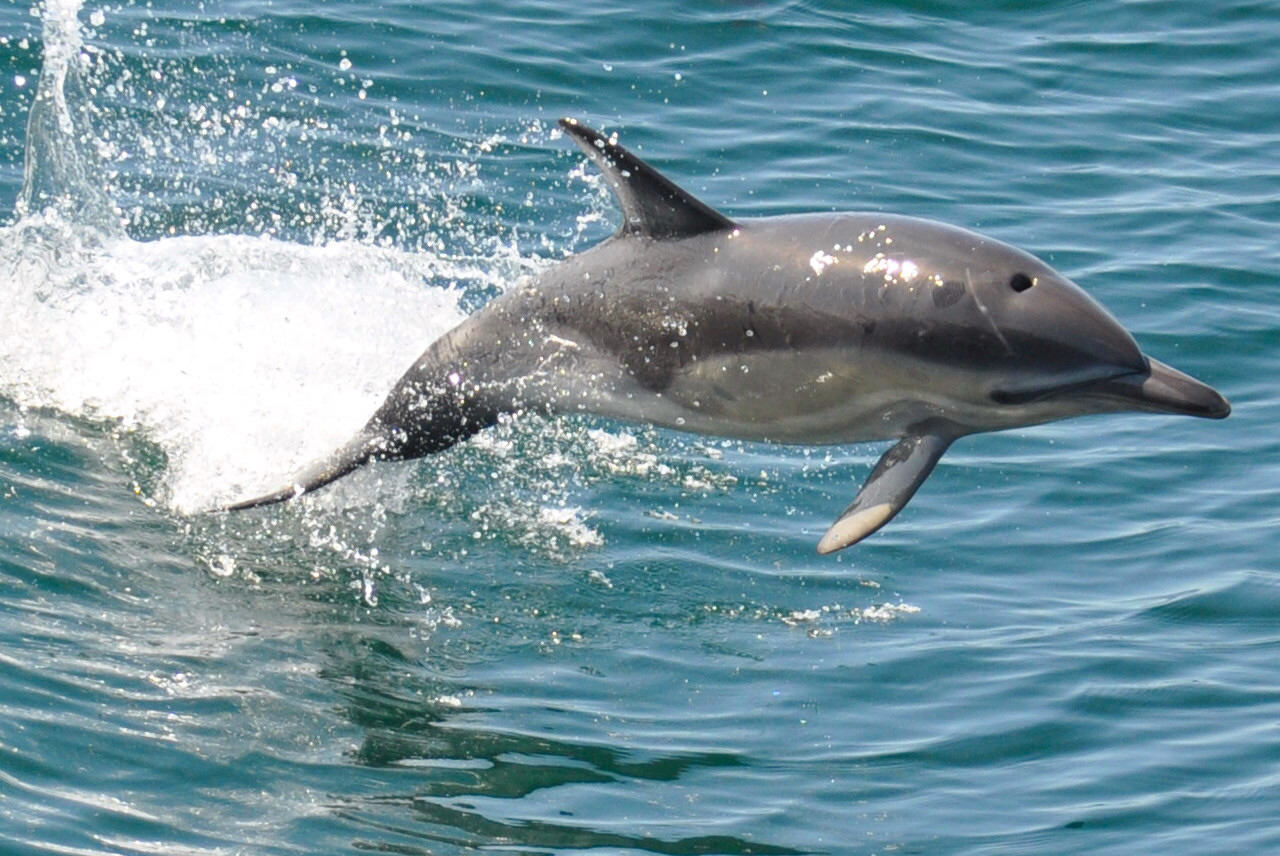
Common Dolphin (photo: bigstockphoto.com)
CURWOOD: How has development affected those marine ecosystems?
KHAN: It’s a great question. We’re still trying to figure this out. The water here once teemed with life - swordfish, marine turtles, Mediterranean Monk seals. Those are largely gone now. What remains are pods of Bottlenose dolphins, the occasional Common dolphin and Harbor porpoises. Even those are now disappearing. Scientists have been watching these since the '80s and '90s say the pod sizes have decreased significantly.
CURWOOD: What are the major threats that they’re facing in their diminishing numbers?
KHAN: The first thing that almost wiped them out during the 20th century was fishing. At that time, cetacean fishing was legal. It’s estimated that some six million cetaceans were killed in the Black Sea. That was stopped in the '80s when Turkey banned cetacean fishing. But as development continued various threats emerged. The first was probably competition from industrial fishing - the Turkish fishery’s no longer sustainable. The fishermen, of course, saw the dolphins as competition, and prey diminished for them. The second was the increasing level of pollution in the waters, and that’s been clear to just about anyone who’s been here. The level of pollution in the water is clearly a threat to any form of marine life. And there’s finally noise. The Bosphorous is much more heavily trafficked now, and as one of the local biologists explained, dolphins are like people, if they can’t sleep in peace or eat in peace they get grumpy - and that’s bad for them.
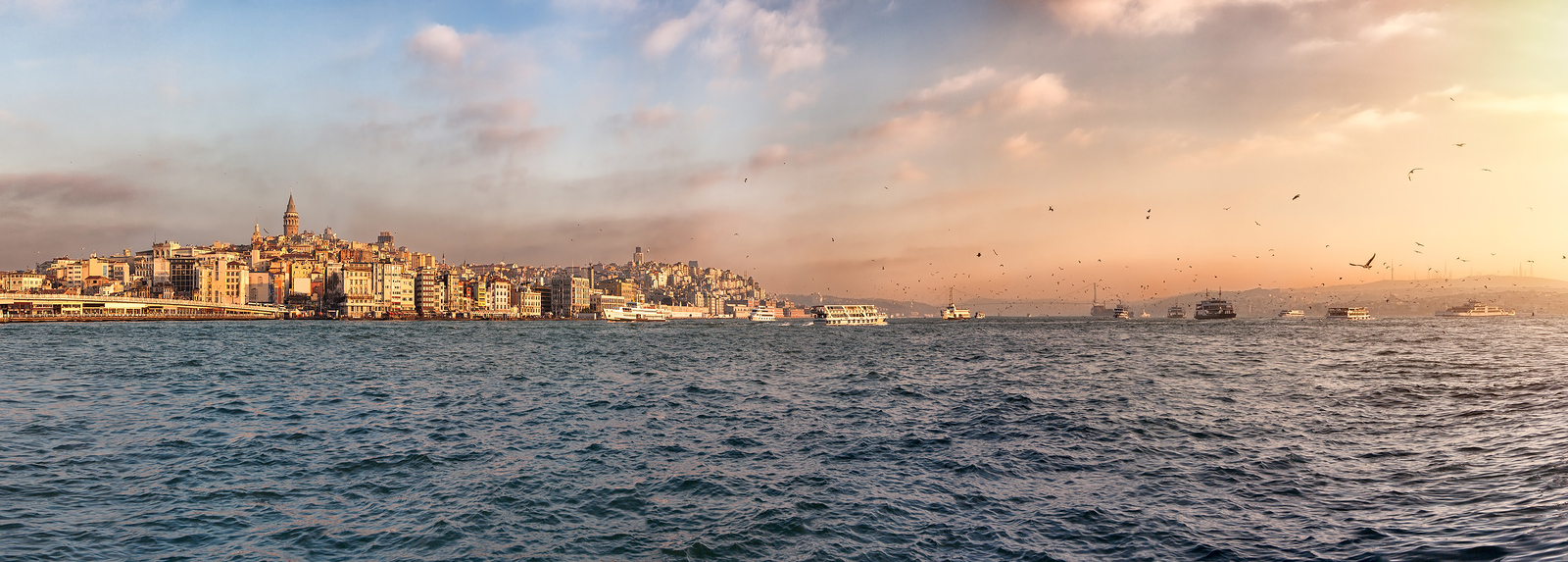
Istanbul from the Bosphorus (photo: bigstockphoto.com)
CURWOOD: What can be done to help these dolphins and porpoises?
KHAN: The first thing that’s been suggested is that areas of the Bosphorous which are of particular importance to cetaceans such as the southern tip of the Bosphorous that opens up to the Mamara be designated as marine protected areas. That would involve limiting the amount of boat traffic there. The second thing that could be done - and this is done with some success in protecting the Mediterranean Monk seals out in the outer gulf of Izmir basin in the Mediterranean - is to get fishermen on the dolphins’ side. One of the things conservation biologists point out is the dolphins as an apex predator are crucial to the long-term health of the ecosystem. If they go, the fish go. It’s incredibly hard to persuade fishermen of that, but if that can be done with the dolphins, it might give them a shot at survival.
CURWOOD: In the end, what do you think people in Turkey think about the balance of development and the environment?
KHAN: It depends very much on whom you ask. As in most countries, which are just beginning to develop very well, the environment isn’t a high priority for most people here. When you’ve only just begun to get regular tap water in your major city, it’s understandable that the environment wouldn’t be top on your list of concerns. For the people who do care about the environment, no cost is too high to pay. And I think it’s those people who might ultimately help convince others, whether it’s dolphins or Monk seals or forested areas around the Black Sea, Turkey’s environmental treasures are worth protecting.
CURWOOD: Sulmaan Khan is a freelance journalist based out of Istanbul. Thanks so much for joining us today.
KHAN: Thank you.
Related link:
Read Sulmaanís article here at Yale's E360
[MUSIC: BIRD NOTE® THEME]
BirdNote © Willow Ptarmigan
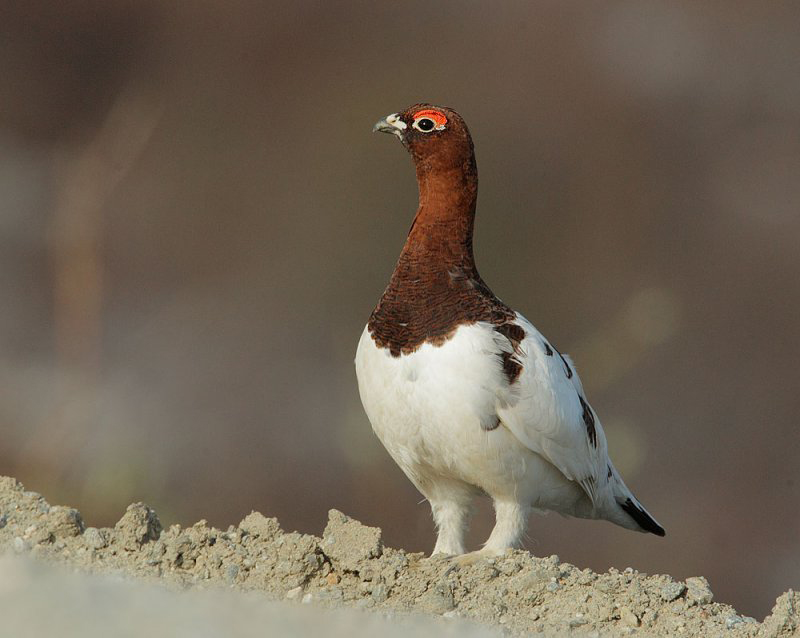
Willow Ptarmigan between plumages (© Tom Grey)
CURWOOD: Usually BirdNote® gives us a chance to take a couple of minutes to marvel at the loveliness of nature. But as Michael Stein reports today, sometimes nature sounds downright goofy.
STEIN: Some bird songs leave us in admiration of their beauty, some with a sense of wonder at their complexity - and others are downright comical.
[CALL OF THE MALE WILLOW PTARMIGAN]
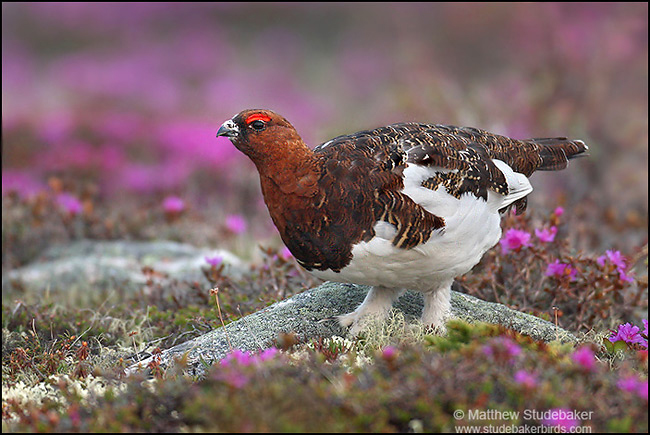
Willow Ptarmigan (© Matthew Studebaker)
STEIN: This male Willow Ptarmigan sounds like he might be laughing, or at least doing his best to make others laugh. As a maker of silly sounds, he beats the Three Stooges hands down.
[CALL OF THE MALE WILLOW PTARMIGAN]
For the male ptarmigan though, these sounds are no laughing matter. Where it nests in the low, dense, shrubby willow tundra of Alaska and Canada, the Willow Ptarmigan crows to attract females and show other males he’s in charge of his stretch of tundra. This stocky, northern relative of grouse and chickens is a bright rusty brown above with a white belly and wings. The hen ptarmigan is so well camouflaged in brown tones, you might be looking right at her and never know it. But the male is another story: picture those white wings propelling that chunky rusty body in a long arc over the tundra…
[FLUTTERING SOUND OF THE WILLOW PTARMIGAN FLYING],
….as he chuckles his way across the tops of the willows.
[CALL OF THE MALE WILLOW PTARMIGAN]
I’m Michael Stein
CURWOOD: To see some photos of the Willow Ptarmigan, check out our website, LOE.org.
[ Written by Bob Sundstrom
Call of the Willow Ptarmigan provided by the Macaulay Library of Natural Sounds at the Cornell Lab of Ornithology, Ithaca, New York. 105769 and 105848 recorded by G.A. Keller.†
Theme music composed and played by Nancy Rumbel and John Kessler.
Producer: John Kessler
Executive Producer: Chris Peterson
© 2013 Tune In to Nature.org††††††May 2013 Narrator: Michael Stein ]
Related link:
Bird Note ©
[MUSIC: The Lee Thompson Ska Orchestra “Napoleon Solo” from The Benevolence Of Sister Mary Ignatius (Axe Attack Limited 2013)]
CURWOOD: Coming up...why fish is the perfect protein for humans - and how you can feel good about eating it. That's next on Living on Earth.
ANNOUNCER: Funding for Living on Earth comes from the Grantham Foundation for the protection of the environment. Supporting strategic communications and collaboration in solving the world’s most pressing environmental problems. The Kendeda Fund, furthering the values that contribute to a healthy planet, and Gilman Ordway for coverage of conservation and environmental change. This is PRI, Public Radio International.
[CUTAWAY MUSIC: Eric Dolphy: “It’s Magic” from Far Cry (Prestige Records 1960)
Happy Birthday Eric 06/20/1928 – 06/29/1964)]
The Perfect Protein
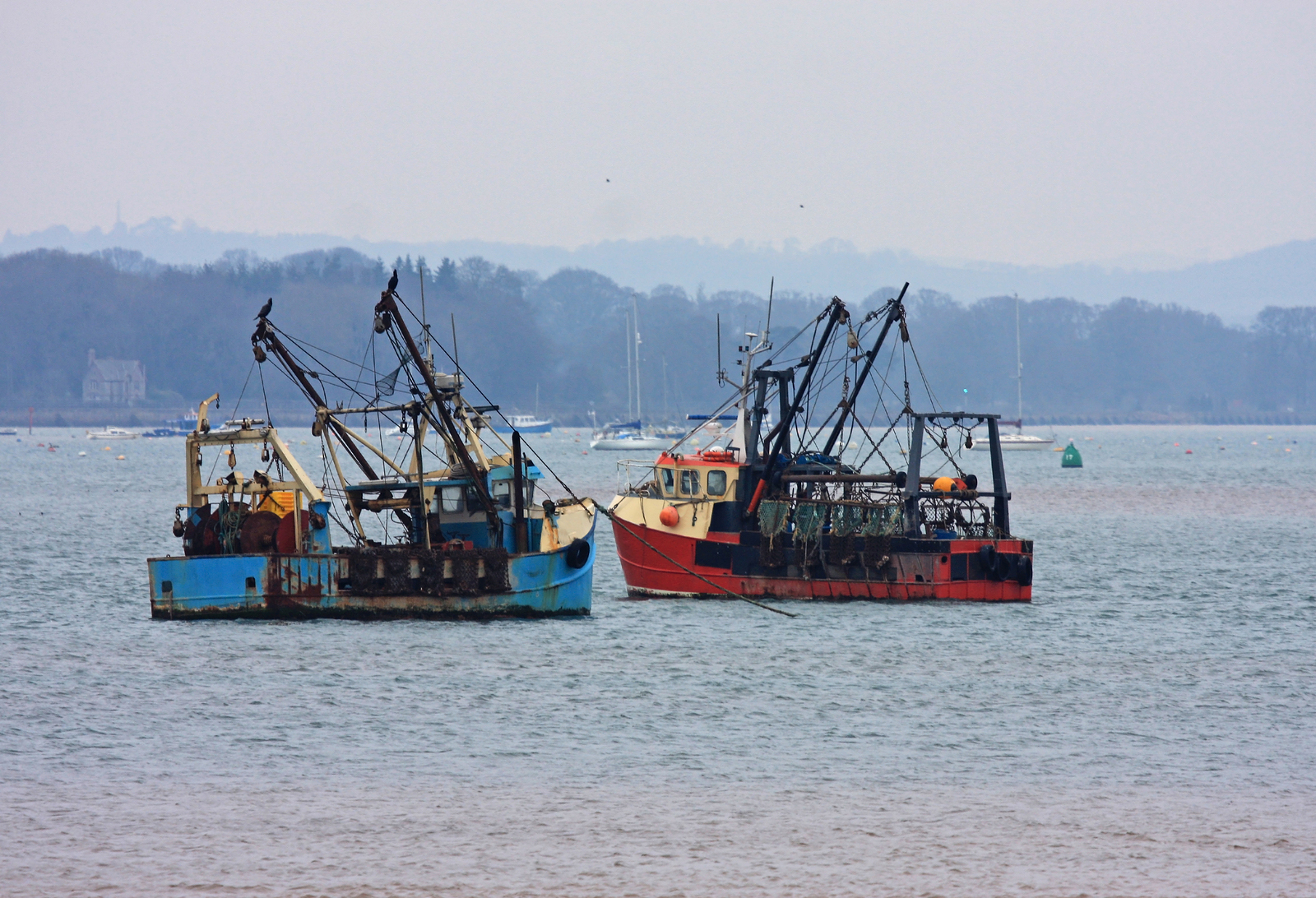
Trawler fishing boats (photo: bigstockphoto.com)
CURWOOD: It's Living On Earth, I'm Steve Curwood. Fish have long been hailed for their remarkable nutritional value, and you may be old enough to have been forced to swallow cod liver oil as your mother told you it was “brain food.” And today doctors say that switching from red meat to seafood can lower the risk of heart disease and cancer in humans. Andy Sharpless, the CEO of the marine advocacy organization Oceana thinks that our fondness for fish may have an evolutionary explanation.
SHARPLESS: It would stand to reason that since our bodies are so tuned up for fish, that they’re so good for us, that there must have been some time in our evolutionary history when we ate a lot of fish. People do speculate that maybe one of the advantages that our ancestors gave us is that they were amongst the first primates to figure this out, and get to the big buffet that is the seashore.
CURWOOD: Seems though, we've overdone it at that big buffet, and though we may be suited to seafood, it’s increasingly difficult to eat fish sustainably. Still, writing in his new book The Perfect Protein, Andy Sharpless argues that we can protect this healthy food and feed our growing population - if only we manage our fisheries better.
SHARPLESS: The problem we have is that is we love them so much that we have, in a very short-sighted way, depleted the ocean bank account, so that the interest, if you will, that an abundant ocean could provide is no longer big enough to feed the mouths that want to eat it. And that’s been driven to a large part by bigger and more industrial scale fishing - those have been the real culprits. Really big boats applying very advanced technology in a very short-sighted and very aggressive fishing practice, and the people responsible are both the government managers who should be setting the rules to keep this resource abundant, and, of course, the bigger fleet operators who have been pushing hard for that.
CURWOOD: You say fish is really good for us and we ought to have it, but we’re eating too much of it. Maybe we should be just giving up on fish.
SHARPLESS: Well, I am of the opposite view. I think that what we have is a very good opportunity to increase the productivity of the ocean by better management, to do so relatively quickly within five or 10 years, if you will stop overfishing, you can rebuild the bank account in the ocean, you can see, therefore, a sustainable level of return each year. In fact, scientific estimates are if a relatively short list of countries would do a good job of managing their oceans, we could see an improvement on the order of 20 to maybe even 40 percent in the total world catch from the previous peak in the late 1980s and have that available for people to eat forever. That’s what good management could produce and do so well in time to have it available for 2050 - when we’ll have another two Chinas worth of people living on the planet.
CURWOOD: What are your rules for managing fisheries? I think you have three.
SHARPLESS: Yes. Set and enforce scientific quotas. Protect the nursery habitat, the areas that small fish need to be able to grow up and not be eaten before they get to reproduction age; protect them from being destroyed by fishing gear that drags along the bottom. And lastly, manage the accidental killing of non-target species that’s called bycatch. If you will do those three things, we’ll increase ocean abundance. You will increase spawning stock, and you will have more fish. And typically, you will get that in a five or 10 year period.
CURWOOD: And by the way, how’s the United States doing with that vision that you have?
SHARPLESS: We are, I’m happy to report, one of the better managed oceans in the world. In 1995, in an act of bipartisanship that used to be possible in our country, President Clinton signed a bill that was sponsored by Senator Stevens, a leading Republican senator from Alaska, which tightened the rules on fishing in American waters. And essentially what it did was, it said to the regulators in Washington, you need to set scientific quotas, you must protect nursery habitat, and you manage what’s called bycatch. In essence, you’ve got to stop overfishing. You got to let the ocean bank account build up. And our oceans are improving. The Pacific in particular has been relatively well-managed. We are the fourth largest ocean country measured by the size of our catch. And we are now able to say, to hold up our heads reasonably high in the world and say, look, we’re showing you how this can done well, and we’re managing our fisheries well.
CURWOOD: Talk to me about the state of fish farming, and how much of a solution to the problem it might be to depleted fisheries.
SHARPLESS: Yes, fish farming seems intuitively, doesn’t it, like it should be part of a solution. I mean if you’re eating a farmed fish, after all, you’re not eating a wild fish. And if wild fisheries need some space to rebuild; let’s all go eat farmed fish. That’s an intuitive, but in some cases wrong logic. Here’s what you need to know when you’re thinking about eating a farmed fish. You need to ask yourself, “what did this farmed fish eat?” And the answer to that question creates three categories of farmed fish - good, bad or indifferent. The “bad” category is if the farmed fish that you’re eating eats fish, if it’s a carnivore. And what would be a common example of that that lots of people eat? Salmon.
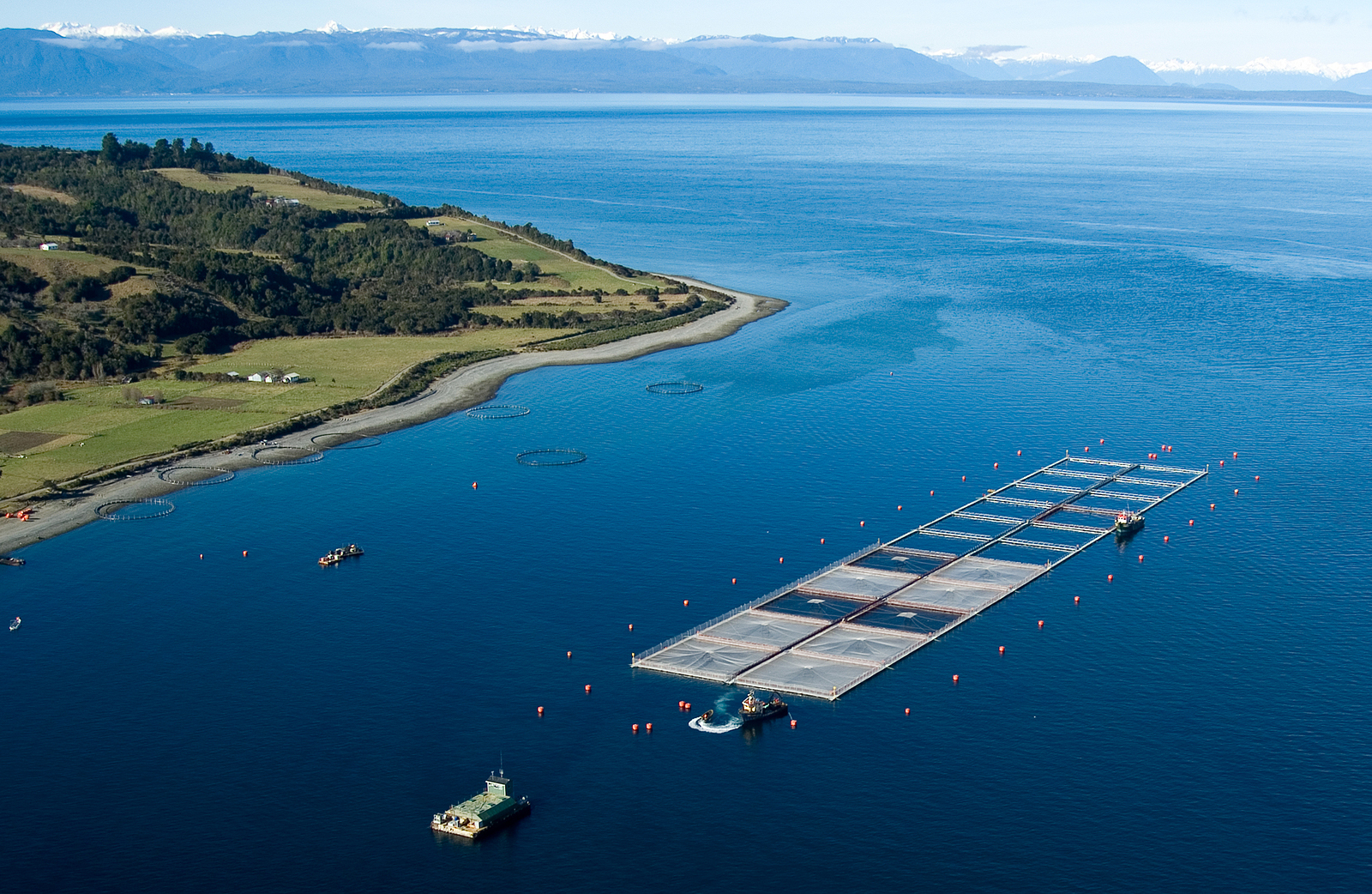
Salmon farming in Chile (photo: bigstockphoto.com)
Salmon is a carnivore. It gets fed in its pens by the farmers wild fish that have been ground up into little pellets. I’ve been to see them in Chile in this ocean pens, they get fed what looks like dog food, they kind of smell like fish. And in the process, they convert four, five pounds of wild fish into one pound of farmed fish. And so it’s a reduction activity. Now at the other end of fish farming, there are farmers farming shellfish: mussels, clams, oysters. And this is something about which we are extremely enthusiastic. People ought to eat as much of those good-tasting things as they can stomach because think about how they grow. They grow by filtering the water. They are eating algae that they are filtering out of the water. They are eating something that we don’t want to eat. And even better in some ways, an oyster farmer is that rarest of things in the world, he is a profit-making or she is a profit-making enterprise providing jobs who wants, indeed must have, a clean ocean, and, therefore is an ally in the battle against pollution.
CURWOOD: So, tell me, as a society, which fish should be eating more of, and which ones should we be eating less of?
SHARPLESS: So we’d like to suggest four, or depending on how you count it, five, simple rules. Eat wild; eat smaller species; eat local or domestic; eat all the farmed shellfish I mentioned - oyster, clams, mussels - that you can; and I’m sorry to say, you’ve got to swear off shrimp.
CURWOOD: Shrimp?
SHARPLESS: Yes, it’s bad news, I’m sorry. There’s no way to get a shrimp and feel good about what you’re doing for the future. Wild shrimp are caught in a process that produces very high levels of what’s called bycatch. And farmed shrimp are farmed in shallow pens typically in tropical countries that are often managed in a very short-sighted way and end up wrecking and contaminating coastal zones. It’s not a pleasant picture to go to Belize where I’ve been and see ocean coastal zones once the shrimp farmers have been through them.
CURWOOD: Now your book seems to present a bit of a conundrum. On the one hand it seems to be advocating saving fish so we can eat more of them. I mean, how fair is that safe to say?
SHARPLESS: Yes, I think that’s a wonderful and provocative summary of my message, and I agree with that. I am saying that. And it does seem kind of counterintuitive. And the reason it does is that ocean fish are the last wild animal that we eat a lot of - all over the world. And because most of what we eat is farmed, we have developed a different relationship to it. But the logic of saving these fish so that we can eat them is no more unfamiliar than the logic one brings to saving money in a bank account or investing in the stock market. We do that because we want the interest, or we want the dividends so that we can spend it. We don’t save our money without the idea of someday spending it - or spending the interest and dividends on it. And that’s the logic that we’re bringing to the moment we’re in on the oceans.
CURWOOD: Andy, what gives you hope? Give me some examples of people who are working to sustainably manage fisheries in the way that you say we should.
SHARPLESS: Well, you can go to the Norwegian cod, which was very badly managed by the Norwegians over 40 years, from the mid-1940s up until 1980s. They finally got around to putting discard bans and the fish came back dramatically in five or 10 years. The New Zealanders had a Rock lobster mismanagement problem, put fishing limits on - again in the ‘80s - that fishery has rebounded. The Norwegian herring, the US haddock, which we mismanaged for 30, 40 years, from ’65 we punished this and drove it down until very low levels in the early 1990s, put fishing limits on, and it has now very strongly rebounded back to almost its original levels as spawning biomass. One of the wonderful things about fish is they are an incredibly powerful and robust part of nature. If we will give them a little bit of room, they will rebound. And you don’t have to wait 100 years for the rainforest to grow back. You can in our lifetimes, go back- plan to go back out into the ocean and see that there’s more fish out there, that we can raise our catch levels, that we can give people more jobs, and that people can eat a lot of this healthy and wonderful protein.
CURWOOD: The end of your book is filled with sustainable seafood recipes. Why did you include this section in your book?
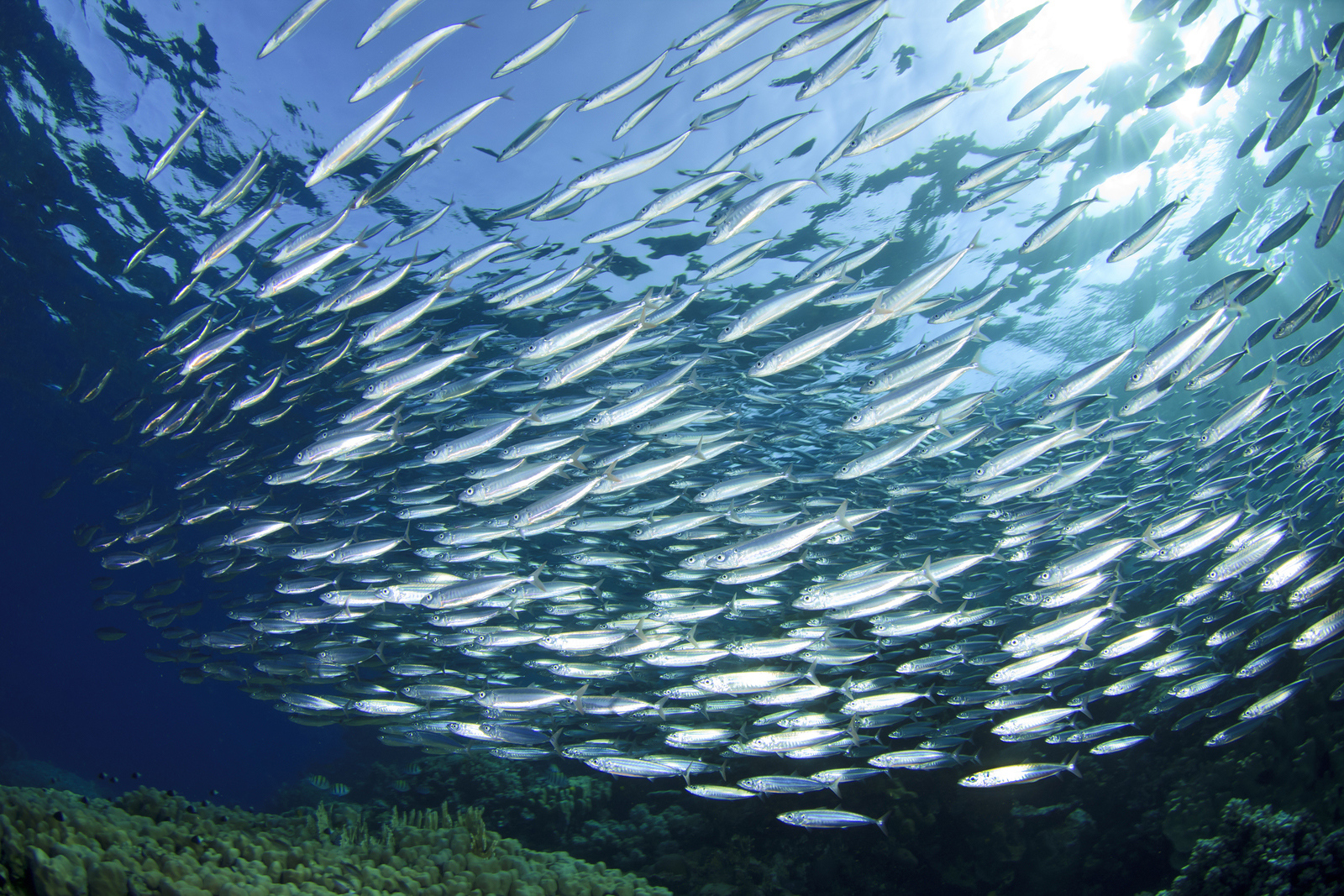
A school of sardines, one of the fishes Andy Sharpless recommends eating more of (photo: bigstockphoto.com)
SHARPLESS: Well, you know, we really wanted it to be clear that we believe that people should eat seafood. And so we asked ourselves, how do we make that totally unambiguously clear in the book, that this is a conservationist book that is promoting seafood consumption? Putting recipes in was good for that dimension. Also frankly, if you talk to people about the category called food, you get a lot more attention than if you talk to people about the category called these creatures that live on the planet with us. So we wanted this book to have as big an audience as possible. And so we wanted to make clear to all the people that love food, this is a book that would appeal to them. One of the nice things about this moment, this kind of a “foodie” moment that we live in is that there’s some wind at our back. And part of the message of the book is to encourage people to eat things like sardines that people may not be so familiar eating.

Andy Sharpless, CEO of Oceana and author of The Perfect Protein (photo: Oceana)
CURWOOD: You know, I have to confess, there’s some small fish that I like, but I’m not a big fan of anchovies.
SHARPLESS: [LAUGHS]
CURWOOD: Have you got a great anchovy recipe?
SHARPLESS: There is. There’s a great anchovy recipe in here by Hugh Fearnley Whittingstall who's a British chef. Yes, I encourage people to get the book, Perfect Protein, and go to the anchovy recipe and give it a try.

Perfect Protein cover (photo: Oceana)
CURWOOD: Andy Sharpless is the CEO of environmental non-profit Oceana, and author of the new book, The Perfect Protein. Thanks for joining us, Andy.
SHARPLESS: My pleasure.
Related links:
- Buy the book online
- Oceana website
- Andy Sharpless' webpage
[MUSIC: Taj Mahal “Tom And Sally Drake” from The Real Thing (Columbia Records 1971)]
Juneteenth

Judith Carney is the author of “In the Shadow Of Slavery: Africa's Botanical Legacy in the Atlantic World.” (University of California Press)
CURWOOD: Since 1865, many African American communities have marked and celebrated their emancipation on June 19. Juneteenth, as it’s known, is a day for picnics and cookouts in honor of the end of American slavery. But often overlooked at those gatherings is the role that Africans and the slave ships played in bringing some of those picnic foods to American tables. Today we revisit how Living on Earth's Ike Sriskandarajah explored the way culture and agriculture overlapped in that dark chapter of American history.
SRISKANDARAJAH: For 1,000 years before the Atlantic slave trade started, the origin of humanity was also its cornucopia. Many of the world’s staple foods first sprouted from African soil. They’re on your picnic table, from the sesame seeds on your bun to the Worcestershire sauce in your hamburger to your slice of watermelon. And if you reach into the cooler…
[COKE CAN OPENS]
CARNEY: The cola in cocoa cola is an African plant as well, the cola nut.
SRISKANDARAJAH: Judith Carney, is the author of In The Shadow of Slavery, Africa’s Botanical Legacy in the Atlantic World. Her book traces the path of foods that traveled with slaves including an ingredient in the world’s most ubiquitous fizzy drink.
CARNEY: Cola came on slave ships - they used cola in the casks of water that were carried on the ships to refresh water that was going bad during the prolonged voyage.
SRISKANDARAJAH: So they were drinking coke 400 years ago on slave ships?
CARNEY: [LAUGHS] No, no, but, you need the coca part of it and the sugar I think. I would say it’s slightly more bitter than eating a potato raw.
SRISKANDARAJAH: Another of our favorite drinks, coffee, also comes out of Africa and millet, black-eyed peas. Judith Carney tracks the migration of these foods through historical records.
CARNEY: I went back and looked at the journals and the diaries of the ship captains and the “slavers”. How are they feeding people for six weeks to three months voyages?
SRISKANDARAJAH: One such log was written by a 17th century slave trader, moored off the coast of western Africa.
[OCEAN WAVES, SEAGULLS SQUAWKING]
MAN 1: A ship that takes in 500 slaves, must provide above a hundred thousand yams; which is very difficult, because it is hard to stow them, by reason they take up so much room; and yet no less ought to be provided, the slaves being of such constitution, that no other food will keep them; so that they sicken and die apace.
SRISKANDARAJAH: The slaver’s human cargo was valuable. So captains bought food the captured Africans could eat, and they bought enough of it. Sometimes the ships would even land in the New World with surplus.
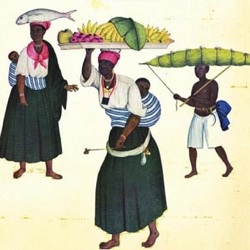
Judith Carney is the author of “In the Shadow Of Slavery: Africa's Botanical Legacy in the Atlantic World.” (University of California Press)
CARNEY: And that I argue, the unwitting conveyance of bringing African food to the Americas was the slave ship.
SRISKANDARAJAH: Once in the Americas the slaves were scattered to work on plantation cash crops. But they were also expected to feed themselves.
CARNEY: We think of plantations as places that produced export crops, but we don’t think about them as also places where human beings had to also know how to farm for their own nourishment.
SRISKANDARAJAH: A Danish Traveler, Johan L. Carstens, wrote a diary describing his observations of the Americas during the early Eighteenth Century
[FIFE MUSIC]
MAN 2: These plantation slaves received nothing from their master in the way of food or clothing except only the small plot of land at the outermost extremity of his plantation land that he assigns to each slave.
SRISKANDARAJAH: The staples from Western Africa flourished in the South, and from those meager plots came a rich food tradition. It was good enough for slaves, it was even good enough for a founding father. Culinary historian Michael Twitty says that Thomas Jefferson actually bought food from his slaves.

Michael Twitty curated the African American Heritage Seed Collection.
TWITTY: Oh yeah, oh yeah. The day to day needs of his own kitchen table, much of that was supplied by the enslaved population of Monticello. There are extensive records of purchases for the main house from the enslaved community. He would buy cabbage, watermelon, he’d buy sprouts.
SRISKANDARAJAH: President Jefferson wasn’t alone.
TWITTY: Before the new immigrants come in at the turn of the 20th century, we are the ethnic restaurateurs of America.
SRISKANDARAJAH: And Twitty says that African Americans didn’t just add ingredients to America’s Melting Pot, they spiced it up too.
TWITTY: Red pepper was the most important, ubiquitous spice.
SRISKANDARAJAH: So important, that in 1780, close to 100 slaves newly imported from West Africa, protested until plantation owner Josiah Collins supplied the spice.
TWITTY: Within a year of their arrival he has to order 1000 pepper pods to season their food because they will not eat bland food. They expressed to him that we want the pepper pods!
SRISKANDARAJAH: Hot sauce has been on most southern tables since. African American cuisine still has its roots in those peripheral plots but, but African Americans’ connection to the land has changed.
TWITTY: We were an agrarian people for millennia even through the period of slavery. We went from being 90 percent agrarian to 90 percent urban in less than a 100 years think about that.
SRISKANDARAJAH: Freedom wasn’t free, emancipation cost the slaves their link to the land. African Americans couldn’t own or lease land - their only option was punitive sharecropping.
TWITTY: All that oppression hurt us in the long run because it divorced us from the land, it divorced us from nature and through food we can reconnect with that and begin to repair that link.
SRISKANDARAJAH: That’s part of Michael Twitty’s mission, he works to bridge that gap. He’s put together the African American Heritage Seed Collection. It offers heirloom seeds to today’s gardeners.
TWITTY: To see an okra plant that you know was growing in gardens of Mt. Vernon or Monticello, to see a kind of rice that was grown in 17th century South Carolina. It gives you the sense of such connection. Because I always tell people my own little corny saying, growing history is knowing history.
SRISKANDARAJAH: And knowing history can turn your bowl of gumbo into a portal back through time. I’m Ike Sriskandarajah. Happy Juneteenth.
Related link:
Check out Michael Twitty's seed collection from the Landreth Company
[MUSIC: Carolina Cholcolate Drops “ Peace Behind The Bridge” from Genuine Negro Jig (Nonesuch Records 2009)]
CURWOOD: We leave you this week in the company of bats.
[MUSIC: “Noctule Bat” from Vanishing Wildlife: A Sound Guide To Britain’s Endangered Species (British Library Sound Archive 2006)]
[BAT CALLS]
In the company of Nyctalus Noctula, the Noctule bat, common across Europe, Asia and North Africa. It's a little over three inches long, with a wing-span of 13 inches.
These are the echo-location calls of a pair of Noctule bats, diving to catch insects on an early June evening, in Kent, England.
Like many bats, Noctules are threatened by intensive agriculture, pesticides and the loss of roosting sites, but so far British bats show no traces of the deadly white-nose syndrome that's killed so many bats in the US.
[BAT CALLS]
These were recorded by Richard Ranft for the British Library CD Vanishing Wildlife.
CURWOOD: Living on Earth is produced by the World Media Foundation. Naomi Arenberg, Bobby Bascomb, Emmett Fitzgerald, Helen Palmer, Poncie Rutsch, Erin Weeks, Adelaide Chen, James Curwood, Jennifer Marquis and Gabriela Romanow all help to make our show. Jeff Turton is our technical director. Alison Lirish Dean composed our themes. You can find us anytime at LOE.org. And check out our Facebook page, it’s PRI’s Living on Earth. And we tweet from @LivingOnEarth. I'm Steve Curwood. Thanks for listening.
ANNOUNCER: Funding for Living on Earth comes from Stonyfield Farm, makers of organic yogurt, smoothies, and more. Stonyfield, working to produce healthy food for a healthy planet. Stonyfield.com. Support also comes from you our listeners, The Go Forward Fund and the Town Creek Foundation.
ANNOUNCER 2: PRI Public Radio International.
Living on Earth wants to hear from you!
Living on Earth
62 Calef Highway, Suite 212
Lee, NH 03861
Telephone: 617-287-4121
E-mail: comments@loe.org
Newsletter [Click here]
Donate to Living on Earth!
Living on Earth is an independent media program and relies entirely on contributions from listeners and institutions supporting public service. Please donate now to preserve an independent environmental voice.
NewsletterLiving on Earth offers a weekly delivery of the show's rundown to your mailbox. Sign up for our newsletter today!
 Sailors For The Sea: Be the change you want to sea.
Sailors For The Sea: Be the change you want to sea.
 The Grantham Foundation for the Protection of the Environment: Committed to protecting and improving the health of the global environment.
The Grantham Foundation for the Protection of the Environment: Committed to protecting and improving the health of the global environment.
 Contribute to Living on Earth and receive, as our gift to you, an archival print of one of Mark Seth Lender's extraordinary wildlife photographs. Follow the link to see Mark's current collection of photographs.
Contribute to Living on Earth and receive, as our gift to you, an archival print of one of Mark Seth Lender's extraordinary wildlife photographs. Follow the link to see Mark's current collection of photographs.
 Buy a signed copy of Mark Seth Lender's book Smeagull the Seagull & support Living on Earth
Buy a signed copy of Mark Seth Lender's book Smeagull the Seagull & support Living on Earth

